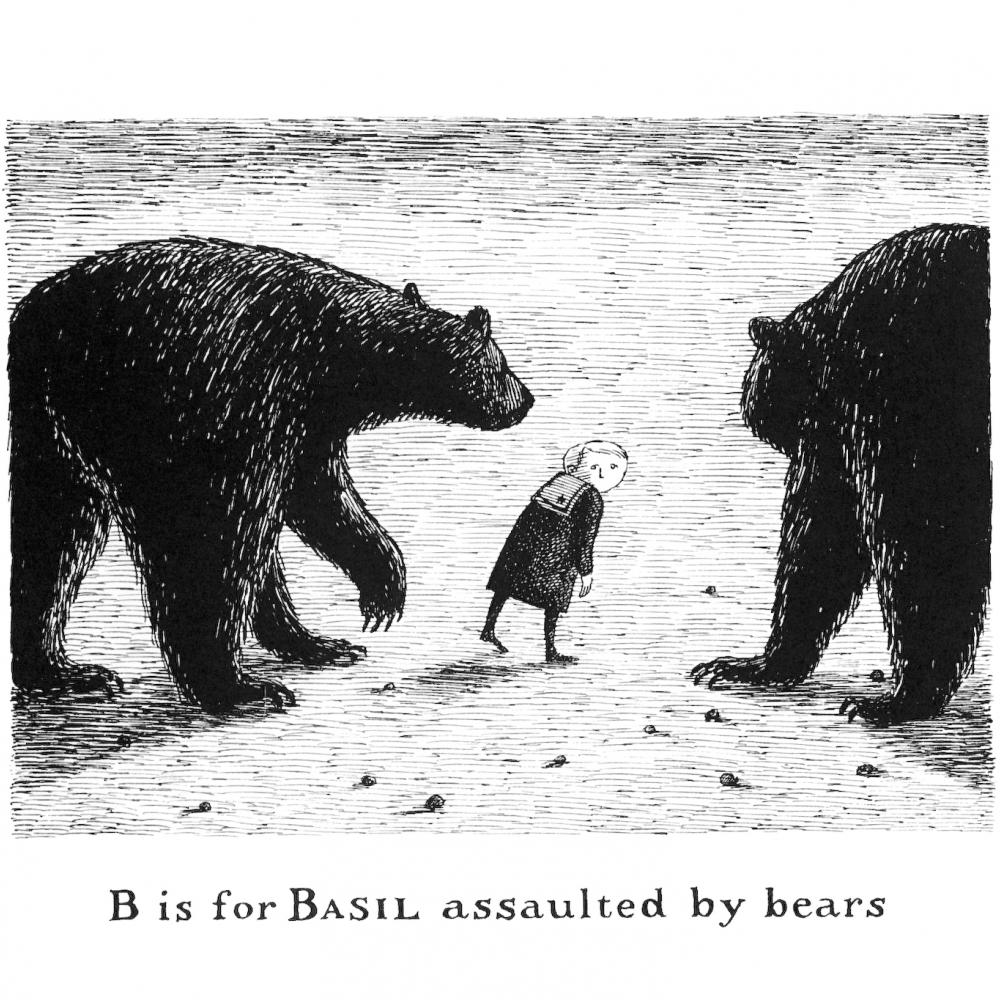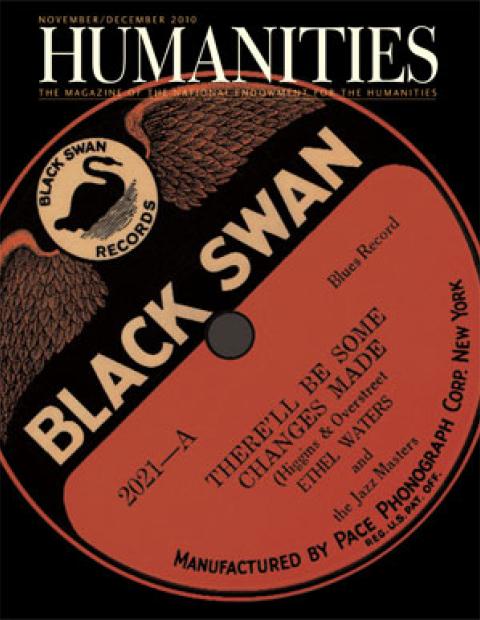A is for AMY who fell down the stairs
B is for BASIL assaulted by bears
C is for CLARA who wasted away
D is for DESMOND thrown out of a sleigh . . .
—From The Gashlycrumb Tinies
In Edward Gorey’s whimsical world, elegantly dressed Edwardian men and women teeter on the brink of demise, uninvited creatures take up residence in dreary mansions, and hapless tots are alphabetically disposed of one by one in rhyming dactylic couplets. Each ghastly event—described with deadpan verse and illustrated with Gorey’s spidery pen-and-ink drawings—maintains a delicate balance between hilarious and horrid.
His witty prose and playful drawings allowed “the viewer to delve into sinister details and plots that would otherwise be too serious or offensive to portray,” says Lisa Yoshihara, curator for the exhibition “Musings of Mystery and Alphabets of Agony: The Work of Edward Gorey” on display at the University of Hawai’i Art Gallery in Honolulu. “Many will find his mixture of whimsy and mystery darkly humorous, his wordcraft incredible, and his elegantly drawn depictions just divine.”
It was this mixture of silliness and dark humor that caused a conundrum for the publishing world. Who was Gorey’s audience? Were these wicked tales meant for children? Would children choking on peaches or being sucked dry by leeches make for a suitable good-night story? Would parents want their children to read books titled The Fatal Lozenge or The Glorious Nosebleed? Or should his work be classified as a parody of children’s literature written for adults? “Gorey intended much of what he wrote for children, but the publishers did not view his work that way, most likely due to the unsettling tragedies and twisted themes where children were at the center,” says Yoshihara.
Not able to find a publisher for many of his works, Gorey eventually created his own imprint, Fantod Press. After publishing his first book, The Unstrung Harp; or, Mr. Earbrass Writes a Novel in 1953—a tale of a novelist struggling with “the unspeakable horror of the literary life”—Gorey began building a fan base by peddling his books to New York bookstores on consignment. A strong working relationship with Andreas Brown at Manhattan’s influential Gotham Book Mart and a 1959 review in the New Yorker, which compared him to Max Ernst and called his work “poetic and poisoned,” are credited for his rise in popularity and eventual success.
Often mistaken for being British (due in part to his well-known animated introduction to PBS’s Mystery! television series, featuring skulking trench-coated sleuths, a lurking caped villain, and a mysterious swooning woman), Gorey was, in fact, American, born in Chicago in 1925. A bright child, he taught himself to read at little more than three years old and began drawing at age four. Around five, the youngster read Dracula and Alice in Wonderland; by eight he devoured Victor Hugo. After a stint in the army, Gorey attended Harvard, majoring in French and rooming with the poet Frank O’Hara, later taking a job with Doubleday in the art department. He also worked as a graphic designer, typographer, playwright, set designer, costume designer (winning a Tony in 1978 for Dracula), and a toy maker. His only formal artistic training consisted of a few classes at the Art Institute of Chicago.
In addition to the more than one hundred books he wrote and illustrated, Gorey provided the illustrations for books authored by Samuel Beckett, H. G. Wells, Charles Dickens, Virginia Woolf, and T. S. Eliot. A lover of wordplay, Gorey also published under pseudonyms Ogdred Weary and E. G. Deadworry, and dozens more, most anagrams of his own name.
Many people assume Gorey’s personality must have been melancholy or brooding, says Yoshihara. Quite the opposite was true. “People thought he was reclusive due to the nature of his writing and art; however, Gorey surprisingly granted many interviews, revealing little glimpses into his life and work, if he felt so inclined toward the interviewer. Friends describe him as calm and compassionate . . . jovial and effervescent, who loved to laugh.” Gorey was a devotee of George Balanchine’s New York City Ballet, never missing a performance for nearly thirty years. When Balanchine died, Gorey retreated to his Cape Cod home, no longer feeling the pull of New York. Also a pop-culture junkie, Gorey watched movies, soap operas, and television shows, counting Buffy the Vampire Slayer, The X-Files, The Mary Tyler Moore Show, The Golden Girls, Third Rock from the Sun, and Frasier among his favorites.
On display through December 10, the exhibition showcases books, illustrations, unpublished works, etchings for Elephantômas and Thumb, posters, handmade toys, and other strange and curious objects collected by Honolulu composer John Carollo, a Goreyphile for more than thirty-five years. Also included are rarely seen original drawings and personal items from the Edward Gorey Charitable Trust and the Edward Gorey House in Yarmouth Port, Massachusetts. Yoshihara moderates a panel discussion featuring Carollo, Rick Jones, director of the Edward Gorey House, and scholar Joseph Stanton on Nov. 4.
Gorey’s work continues to inspire artists from cartoonists and punk rock musicians to a group of twenty-six gothic partygoers who attended the annual Edwardian costume ball in San Francisco, each dressed as one of the doomed “tinies.” Yoshihara says, “One only has to look at YouTube to see countless performances.”
Shortly before his death in 2000, Gorey reflected on his prolific career: “My name turns up in a review of a book or something where they say it’s very ‘Edward Goreyish’ or something like that. That happens often enough, so I feel I've made a tiny mark somewhere.”


